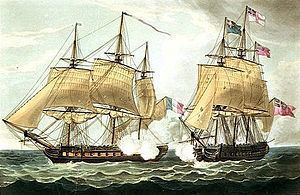Name Clorinde Laid down 19 July 1806 Name Aurora Construction started 19 July 1806 Length 47 m Beam 12 m | Namesake Clorinda Captured 26 February 1814 Acquired 26 February 1814 Launched 1808 Displacement 1.08 million kg | |
 | ||
The Clorinde was a 40-gun Pallas-class frigate of the French Navy, designed by Sané. The British Royal Navy captured her in 1814 and renamed her HMS Aurora. After 19 years as a coal hulk she was broken up in 1851.
Contents
Career
From June 1809, she was stationed with the 16-gun Milan and the 38-gun Renommée. In September, she sailed with Renommée, Loire, and Seine to Guadeloupe. On 13 December, she and Renommée captured HMS Junon.
On 15 December 1809, Clorinde ran aground, and freed herself by dropping guns and ammunition overboard.
She took part in the Action of 20 May 1811, fought off Madagascar, and returned to Brest. Captain Jacques Saint-Cricq was found guilty of failing to properly support his commodore, and demoted of rank, expelled from the Legion of Honour, and sentenced to three years in prison.
On 6 December 1813, Clorinde captured the British merchant vessel Lusitania in the Atlantic Ocean (44°30′N 10°30′W). Lusitania, Johnston, master, had been sailing from London to Suriname. Clorinde then put the crews of four other vessels that she had captured aboard Lusitania and sent her into Plymouth. The other four were:
Clorinde abandoned Blenden Hall at sea, where the Falmouth packet Eliza, homeward bound from Malta, found her floating. HMS Challenger brought Blenden Hall into Plymouth. They arrived on 19 December, on the same day as Lusitania.
On 25 February 1814, at 47°40′N 9°30′W, and under Commander René Joseph Marie Denis-Lagarde, she was chased by the 38-gun HMS Eurotas. A violent fight ensued for two hours and 20 minutes that left both ships dismasted, Eurotas suffering 20 killed and 30 wounded (including Captain John Phillimore), and Clorinde, 40 killed and 80 wounded. During the night, the ships built jury rigs and resumed the pursuit the next day, when HMS Dryad and HMS Achates intervened. The helpless Clorinde struck after the first cannon shot from Dryad, who towed her to Portsmouth.
Clorinde was brought into British service as HMS Aurora. She served off South America from 1821-25 and in the Caribbean from 1826-28.
Fate
From January 1832, she was used as a coal depot in Falmouth. She was eventually broken up in May 1851.
